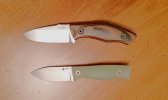Spyderco likes choils. No denying that. They definitely do not focus on blade to handle ratios.
Three of the four you picked have backlocks. A backock usually implements a kick to prevent the blade from touching the backspacer. This kick automatically requires a ricasso of some sort thus reducing this ratio even on knives which lack a choil. Unless the kick is omitted a backlock will never be competitive in blade to handle ratio. It has nothing to do with being a flipper but is about the lock choice and lack of a choil.
You will need to look at Spydies which are not backlocks and which do not have choils. Most of those are collaborations and not in house designs. There are a few exceptions.
Pattada
Mantra
Southard
Positron
K2
Centofante Memeory
Slysz Bowie
I realize this is important to a lot of people but I am not one of them. Personally to me this is bench racing. In use their tools just flat out work. This is just my take on it. To each their own.





